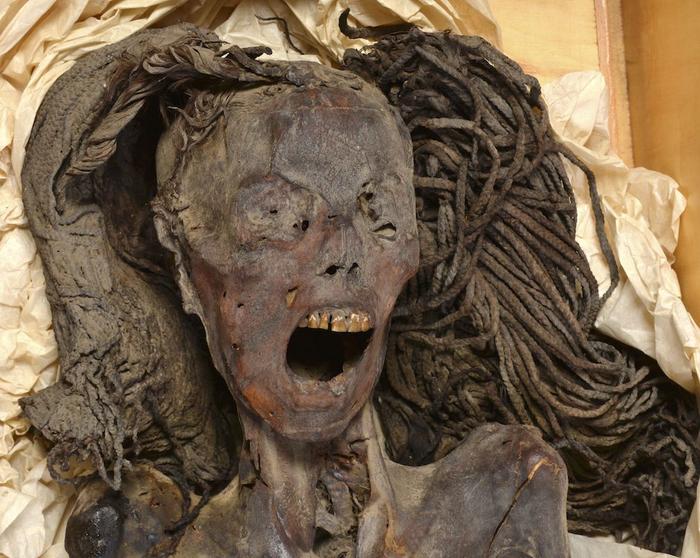The 3,500-year-old remains of an Egyptian woman are being investigated by a team of researchers, who have employed advanced scientific techniques to better understand how and why this individual, popularly known as the “Screaming Woman,” may have died.
“Here we show that she was embalmed with costly, imported embalming material,” said Dr. Sahar Saleem, a professor of radiology at Kasr Al Ainy Hospital of Cairo University in a recent press release. “This, and the mummy’s well-preserved appearance, contradicts the traditional belief that a failure to remove her inner organs implied poor mummification.”
Saleem and the team’s findings, published in Frontiers in Medicine, reveal fascinating new insights into this longstanding ancient mystery.
Who is the Screaming Woman?
In 1935, an expedition to Egypt sponsored by the Metropolitan Museum of New York was underway. During their excavation at Deir Elbahari near Luxor, the ancient site of Thebes, they unearthed the tomb of Senenmut, the architect and overseer of royal works, who was also rumored to be the lover of Queen Hatshepsut (1479-1458 BCE).
Queen Hatshepsut is considered one of the most brilliant women of her time, as she led Egypt as the first female pharaoh, causing a stir from many of her countrymen. After she died, her stepson, Thutmose III, tried to erase every indication of her existence. However, archaeologists were able to find records of her reign and from there, bring her story to light, including rumors about her relationship with Senmut.
In 1935, the researchers found not only Senenmut’s tomb but also a separate burial chamber for his mother, Hat-Nufer, and other unidentified relatives beneath it.
Among these remains, the team made an eerie discovery: a wooden coffin containing the mummy of a woman wearing a black wig and two scarab rings in silver and gold. What struck the archaeologists most was the mummy’s expression, with her mouth wide open as if locked in a scream, prompting them to dub the remains the “Screaming Woman.”
What Happened to Screaming Woman?
For many years, until 1998, the Screaming Woman had been housed at the Kasr Al Ainy School of Medicine in Cairo, where numerous royal mummies, including that of Tutankhamun, were studied.
Later, she was moved to the Cairo Egyptian Museum at the Ministry of Antiquities’ request. Since her discovery in 1935, the mummy’s coffin and rings have been displayed at the Metropolitan Museum of New York.
More recently, Dr. Saleem and her co-author, Dr. Samia El-Merghani, wanted to understand better how Screaming Woman died, as it might reveal further information as to why she died. The researchers used CT scans to dissect the mummy virtually, estimating her age, identifying any abnormalities, and assessing her state of preservation. They also utilized advanced techniques like scanning electron microscopy (SEM), Fourier transform infrared spectroscopy (FTIR), and x-ray diffraction analysis (XRD) to identify the embalming materials used.


The researchers found that the mummy was still in remarkable condition, even 2,500 years after her burial. Their investigation revealed that she had been unwrapped, lying with her legs extended and hands folded above her groin.
From 2D and 3D CT images, the researchers estimated that the Screaming Woman was approximately 1.54 meters tall in life and around 48 years old at the time of her death. She had suffered from mild arthritis of the spine, evident from the presence of osteophytes or ‘bone spurs’ on her vertebrae.
She was missing several teeth, likely lost before death, with evidence of bone resorption—a natural healing process following tooth loss. Other teeth showed signs of wear and breakage.
“Teeth lost during life may have been extracted. Dentistry had originated in ancient Egypt, with Hesy Re the first recorded physician and dentist in the world,” said Saleem in the press release.
Embalming Screaming Woman
What struck the researchers was that the mummy had no embalming incision, and her brain, diaphragm, heart, lungs, liver, spleen, kidneys, and intestines were still intact. This was surprising, as the typical mummification process in the New Kingdom (1550–1069 BCE) included the removal of all organs except the heart.
FTIR analysis revealed that she had been embalmed with juniper and frankincense—expensive materials imported from the Eastern Mediterranean and East Africa or Southern Arabia, respectively. Her natural hair had been dyed with henna and juniper, and her wig, made from date palm fibers, had been treated with quartz, magnetite, and albite crystals to stiffen the locks and give them the black color favored by ancient Egyptians, symbolizing youth.
“These findings support the ancient trade of embalming materials in ancient Egypt,” explained Saleem in the press release. “The expedition led by Queen Hatshepsut brought frankincense from Punt (possibly Somalia in Africa). The tomb of Tutankhamun also contained frankincense and juniper.”
How Did Screaming Woman Die?
While their various tests and scans revealed much about the woman’s burial, the researchers could not determine how the woman died. They also remain mystified by the screaming expression, although Saleem suggested that it might be a cadaveric spasm. This involves a rare form of muscular stiffening associated with violent deaths under extreme physical conditions and intense emotion, implying that she may have died in agony or pain, although what may have caused this remains a mystery.
“The Screaming Woman is a true ‘time capsule’ of the way that she died and was mummified,” Saleem said, acknowledging that while many questions remain about this 3,500 years ago enigma, the recent findings offer fresh clues about the mysterious life and death of this Egyptian woman whose remains continue to captivate archaeologists and historians.
Kenna Hughes-Castleberry is the Science Communicator at JILA (a world-leading physics research institute) and a science writer at The Debrief. Follow and connect with her on X or contact her via email at kenna@thedebrief.org

